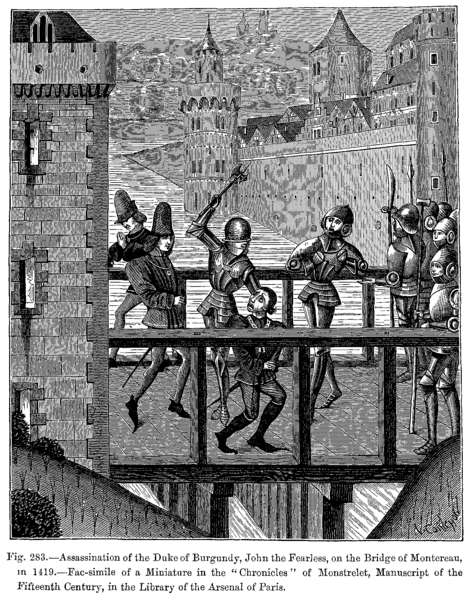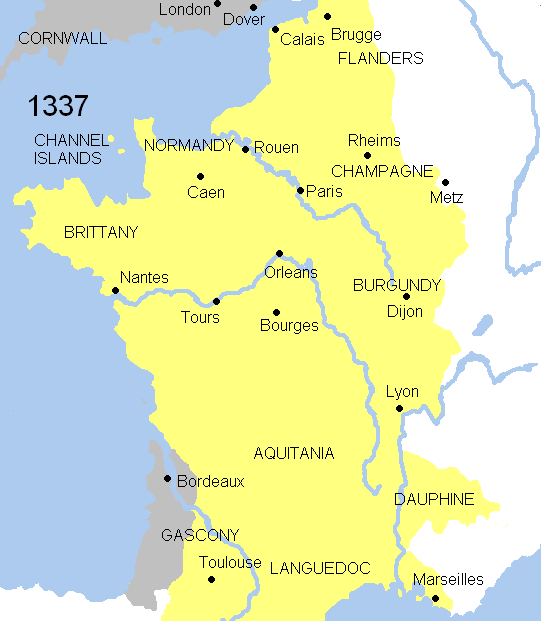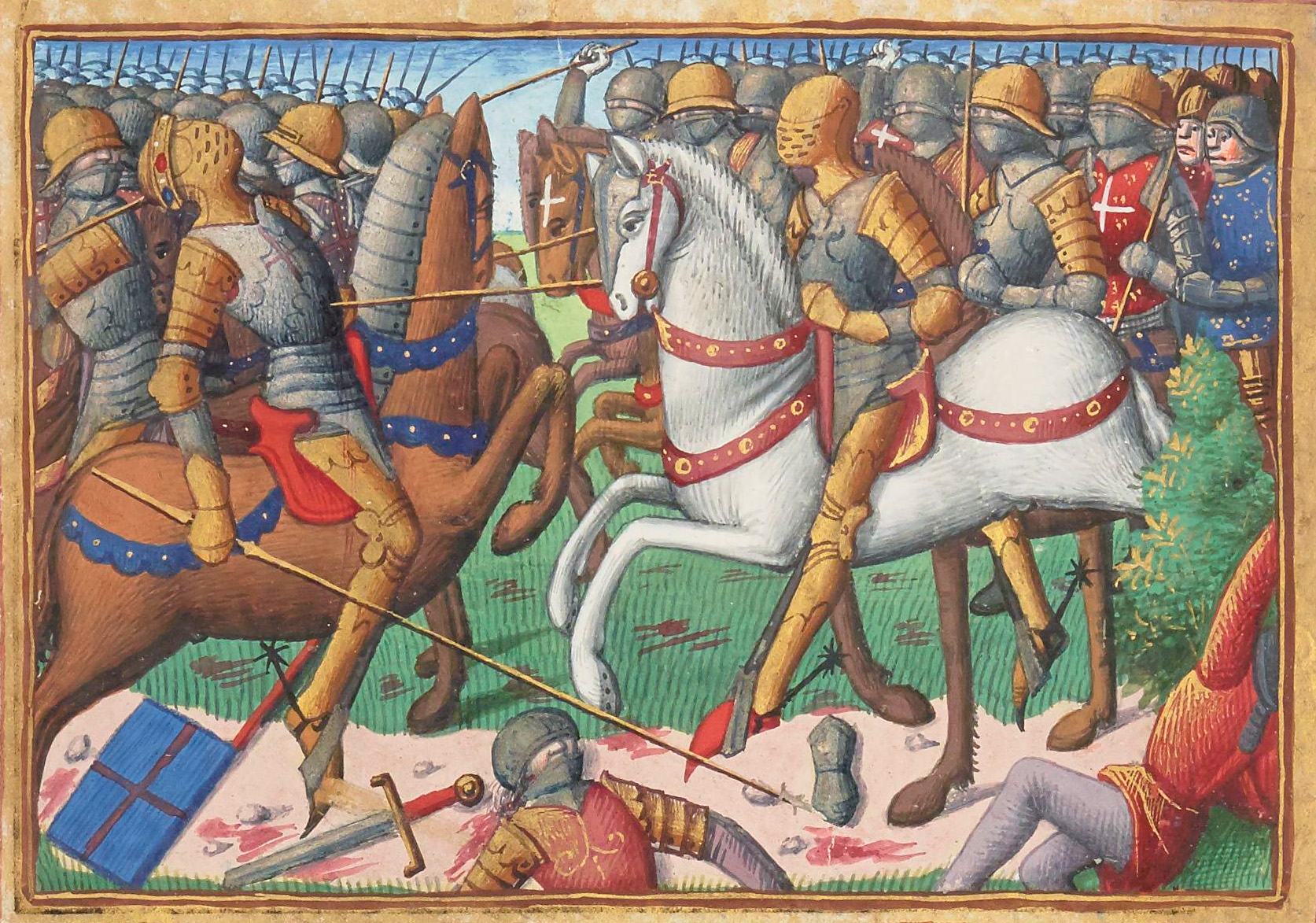|
Treaty Of Bourges
The Treaty of Bourges was an agreement between Henry IV, King of England and Charles, Duke of Orléans signed on 18 May 1412. In return for military aid against the Burgundians, the Armagnacs offered Henry IV full sovereignty in Gascony. Due to a temporary peace between the Armagnacs and Burgundians, the treaty was never fulfilled. Context In November 1407, Louis I, Duke of Orléans was assassinated, starting a civil war in France between the Armagnacs and the Burgundians. In consequence, both parties sought Henry IV's assistance for the war. In 1411, Henry IV sent a small contingent to help John the Fearless, Duke of Burgundy. In 1412, the Armagnacs offered the restitution of Aquitaine in return for military aid. Agreement On May 18, 1412, the Armagnacs recognized the sovereignty of Henry IV in the Duchy of Aquitaine in return for an army of 4,000 men. As part of the agreement, Thomas of Lancaster, Duke of Clarence, devastated western France south of the Loire The Loire ( ... [...More Info...] [...Related Items...] OR: [Wikipedia] [Google] [Baidu] |
Henry IV Of England
Henry IV ( April 1367 – 20 March 1413), also known as Henry Bolingbroke, was King of England from 1399 to 1413. He asserted the claim of his grandfather King Edward III, a maternal grandson of Philip IV of France, to the Kingdom of France. Henry was the first English ruler since the Norman Conquest, over three hundred years prior, whose mother tongue was English rather than French. Henry was the son of John of Gaunt, Duke of Lancaster, himself the son of Edward III. John of Gaunt was a power in England during the reign of Henry's cousin Richard II. Henry was involved in the revolt of the Lords Appellant against Richard in 1388, resulting in his exile. After John died in 1399, Richard blocked Henry's inheritance of his father's duchy. That year, Henry rallied a group of supporters, overthrew and imprisoned Richard II, and usurped the throne, actions that later would lead to what is termed the Wars of the Roses and a more stabilized monarchy. As king, Henry faced a ... [...More Info...] [...Related Items...] OR: [Wikipedia] [Google] [Baidu] |
Charles, Duke Of Orléans
Charles of Orléans (24 November 1394 – 5 January 1465) was Duke of Orléans from 1407, following the murder of his father, Louis I, Duke of Orléans. He was also Duke of Valois, Count of Beaumont-sur-Oise and of Blois, Lord of Coucy, and the inheritor of Asti in Italy via his mother Valentina Visconti. He is now remembered as an accomplished medieval poet, owing to the more than five hundred extant poems he produced, written in both French and English, during his 25 years spent as a prisoner of war and after his return to France. Accession Charles was born in Paris, the son of Louis I, Duke of Orléans and Valentina Visconti, daughter of Gian Galeazzo Visconti, Duke of Milan. He acceded to the duchy at the age of thirteen after his father had been assassinated on the orders of John the Fearless, Duke of Burgundy. Charles was expected to carry on his father's leadership against the Burgundians, a French faction which supported the Duke of Burgundy. The latter was ... [...More Info...] [...Related Items...] OR: [Wikipedia] [Google] [Baidu] |
Burgundian (party)
The Burgundian party was a political allegiance against France that formed during the latter half of the Hundred Years' War. The term "Burgundians" refers to the supporters of the Duke of Burgundy, John the Fearless, that formed after the assassination of Louis I, Duke of Orléans. Their opposition to the Armagnac party, the supporters of Charles, Duke of Orléans, led to a civil war in the early 15th century, itself part of the larger Hundred Years' War. Geography The Duke of Burgundy had inherited a large number of lands scattered from what is now the border of Switzerland up to the North Sea. The Duchy of Burgundy had been granted as an appanage to Philip the Bold in the 14th century, and this was followed by other territories inherited by Philip and his heirs during the late 14th and 15th centuries, including the County of Burgundy (the Franche-Comté), Flanders, Artois and many other domains in what are now Belgium, Luxembourg, the Netherlands and northeastern France. Pr ... [...More Info...] [...Related Items...] OR: [Wikipedia] [Google] [Baidu] |
Armagnac (party)
The Armagnac faction was prominent in French politics and warfare during the Hundred Years' War. It was allied with the supporters of Charles, Duke of Orléans against John the Fearless after Charles' father Louis of Valois, Duke of Orléans, Louis of Orléans was Assassination of Louis I, Duke of Orléans, killed on a Paris street on the orders of the Duke of Burgundy on 23 November 1407. The Armagnac Faction took its name from Charles' father-in-law, Bernard VII, Count of Armagnac (1360–1418), who guided the young Duke during his teens and provided much of the financing and some of the seasoned Gascony, Gascon troops that besieged Paris before their defeat at Saint-Cloud. Origins In 1407, Louis of Valois, Duke of Orléans, Louis of Orléans was assassinated on the order of John the Fearless. Fearing Burgundian (party), Burgundian ambitions, the dukes of Duke of Berry, Berry, List of rulers of Brittany, Brittany, and Duke of Orléans, Orléans, and the counts of Count of Ale ... [...More Info...] [...Related Items...] OR: [Wikipedia] [Google] [Baidu] |
Gascony
Gascony (; french: Gascogne ; oc, Gasconha ; eu, Gaskoinia) was a province of the southwestern Kingdom of France that succeeded the Duchy of Gascony (602–1453). From the 17th century until the French Revolution (1789–1799), it was part of the combined Province of Guyenne and Gascony. The region is vaguely defined, and the distinction between Guyenne and Gascony is unclear; by some they are seen to overlap, while others consider Gascony a part of Guyenne. Most definitions put Gascony east and south of Bordeaux. It is currently divided between the region of Nouvelle-Aquitaine (departments of Landes, Pyrénées-Atlantiques, southwestern Gironde, and southern Lot-et-Garonne) and the region of Occitanie (departments of Gers, Hautes-Pyrénées, southwestern Tarn-et-Garonne, and western Haute-Garonne). Gascony was historically inhabited by Basque-related people who appear to have spoken a language similar to Basque. The name Gascony comes from the same root as the word Basq ... [...More Info...] [...Related Items...] OR: [Wikipedia] [Google] [Baidu] |
Louis I, Duke Of Orléans
Louis I of Orléans (13 March 1372 – 23 November 1407) was Duke of Orléans from 1392 to his death. He was also Duke of Touraine (1386–1392), Count of Valois (1386?–1406) Blois (1397–1407), Angoulême (1404–1407), Périgord (1400–1407) and Soissons (1404–07). He was the younger brother of King Charles VI of France, and a powerful and polarizing figure in his day. Owing to the King's highly public struggles with mental illness, Louis worked with Charles' wife Queen Isabeau to try to lead the kingdom during Charles' frequent bouts of insanity. He struggled for control of France with John the Fearless, Duke of Burgundy. Louis was unpopular with the citizens of Paris due to his reputation for womanizing and his role in the ''Bal des Ardents'' tragedy, which resulted in the deaths of four French nobles and the near death of the king himself. He was assassinated in 1407 on orders of John the Fearless; John not only admitted to his role i ... [...More Info...] [...Related Items...] OR: [Wikipedia] [Google] [Baidu] |
Armagnac–Burgundian Civil War
The Armagnac–Burgundian Civil War was a conflict between two cadet branches of the French royal family – the House of Orléans (Armagnac faction) and the House of Burgundy ( Burgundian faction) from 1407 to 1435. It began during a lull in the Hundred Years' War against the English and overlapped with the Western Schism of the papacy. Causes The leaders of both parties were closely related to the French king through the male line. For this reason, they were called " princes of the blood", and exerted much influence on the affairs of the kingdom of France. Their rivalries and disputes for control of the government would serve as much of the basis for the conflict. The Orléans branch of the family, also referred to as House of Valois-Orléans, stemmed from Louis I, Duke of Orléans, younger son of King Charles V of France (r. 1364–1380). The House of Valois-Burgundy originated from Charles V's youngest brother, Philip the Bold, the Duke of Burgundy. Both their respective names ... [...More Info...] [...Related Items...] OR: [Wikipedia] [Google] [Baidu] |
John The Fearless
John I (french: Jean sans Peur; nl, Jan zonder Vrees; 28 May 137110 September 1419) was a scion of the French royal family who ruled the Burgundian State from 1404 until his death in 1419. He played a key role in French national affairs during the early 15th century, particularly in the struggles to rule the country for the mentally ill King Charles VI, his cousin, and the Hundred Years' War with England. A rash, ruthless and unscrupulous politician, John murdered the King's brother, the Duke of Orléans, in an attempt to gain control of the government, which led to the eruption of the Armagnac–Burgundian Civil War in France and in turn culminated in his own assassination in 1419. The involvement of Charles, the heir to the French throne, in his assassination prompted John's son and successor Philip to seek an alliance with the English, thereby bringing the Hundred Years' War to its final phase. John played an important role in the development of gunpowder artillery in E ... [...More Info...] [...Related Items...] OR: [Wikipedia] [Google] [Baidu] |
Duke Of Burgundy
Duke of Burgundy (french: duc de Bourgogne) was a title used by the rulers of the Duchy of Burgundy, from its establishment in 843 to its annexation by France in 1477, and later by Holy Roman Emperors and Kings of Spain from the House of Habsburg who claimed Burgundy proper and ruled the Burgundian inheritance in the Low Countries. The Duchy of Burgundy was a small portion of the traditional lands of the Burgundians west of the river Saône which, in 843, was allotted to Charles the Bald's West Franks, kingdom of West Franks. Under the Ancien Régime, the Duke of Burgundy was the premier lay Peerage of France, peer of the kingdom of France. Beginning with Robert II of France, the title was held by the House of Capet, Capetians, the French royal family. It was granted to Robert's younger son, Robert I, Duke of Burgundy, Robert, who founded the House of Burgundy. When the senior line of the House of Burgundy became extinct, it was inherited by John II of France through proximity of ... [...More Info...] [...Related Items...] OR: [Wikipedia] [Google] [Baidu] |
Duchy Of Aquitaine
The Duchy of Aquitaine ( oc, Ducat d'Aquitània, ; french: Duché d'Aquitaine, ) was a historical fiefdom in western, central, and southern areas of present-day France to the south of the river Loire, although its extent, as well as its name, fluctuated greatly over the centuries, at times comprising much of what is now southwestern France (Gascony) and central France. It originated in the 7th century as a duchy of Francia, ultimately a recreation of the Roman provinces of . As a duchy, it broke up after the conquest of the independent Aquitanian duchy of Waiofar, going on to become a sub-kingdom within the Carolingian Empire. It was then absorbed by West Francia after the 843 partition of Verdun and soon reappeared as a duchy under it. In 1153, an enlarged Aquitaine pledged loyalty to the Angevin kings of England. As a result, a rivalry emerged between the French monarchs and the Angevins over control of the latter's territorial possessions in France. By the mid-13th century, onl ... [...More Info...] [...Related Items...] OR: [Wikipedia] [Google] [Baidu] |
Thomas Of Lancaster, 1st Duke Of Clarence
Thomas of Lancaster, Duke of Clarence (autumn 1387 – 22 March 1421) was a medieval English prince and soldier, the second son of Henry IV of England, brother of Henry V, and heir to the throne in the event of his brother's death. He acted as councillor and aide to both. His father appointed him Lord Lieutenant of Ireland in 1401. Thomas, who was only fourteen, landed in Dublin in November 1401, and spent much of the next eight years in Ireland.Otway-Ruthven p.341 He was nearly killed in a skirmish near Dublin in 1406. He seems to have been a conscientious Governor there, but was hampered in his efforts to keep the peace by the chronic shortage of money in Ireland.Otway-Ruthven p.343 Military career During the wars of his elder brother Henry V in France, Clarence fought in both the Siege of Caen and the Siege of Rouen (29 July 1418 – 19 January 1419), where he commanded the besieging force. After Henry had negotiated the Treaty of Troyes, in which he became heir to the ... [...More Info...] [...Related Items...] OR: [Wikipedia] [Google] [Baidu] |
Duke Of Clarence
Duke of Clarence is a substantive title which has been traditionally awarded to junior members of the British Royal Family. All three creations were in the Peerage of England. The title was first granted to Lionel of Antwerp, the second son of King Edward III, in 1362, as he had married a ''de Clare'' heiress with estates including Clare in Suffolk. Since he died without sons, the title became extinct. The title was again created in favour of Thomas of Lancaster, the second son of King Henry IV, in 1412. Upon his death, too, the title became extinct. The last creation in the Peerage of England was for George Plantagenet, brother of King Edward IV, in 1461. The Duke forfeited his title in 1478, after he had been convicted of treason against his brother. He allegedly met his end by being drowned in a butt of Malmsey (according to William Shakespeare). A fourth creation in England was suggested and planned to take effect; the title of Duke of Clarence was going to be give ... [...More Info...] [...Related Items...] OR: [Wikipedia] [Google] [Baidu] |





